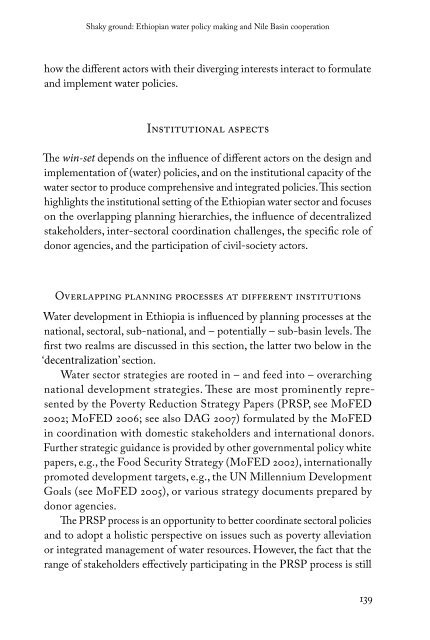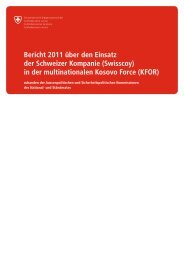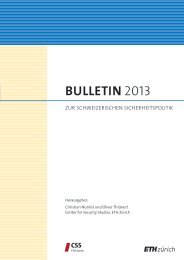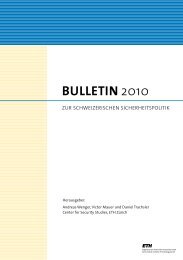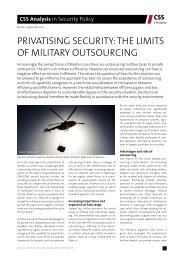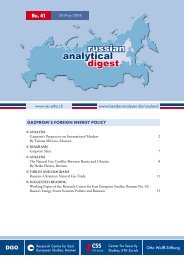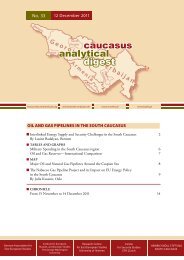Double-Edged Hydropolitics on the Nile - Center for Security Studies ...
Double-Edged Hydropolitics on the Nile - Center for Security Studies ...
Double-Edged Hydropolitics on the Nile - Center for Security Studies ...
You also want an ePaper? Increase the reach of your titles
YUMPU automatically turns print PDFs into web optimized ePapers that Google loves.
Shaky ground: Ethiopian water policy making and <strong>Nile</strong> Basin cooperati<strong>on</strong><br />
how <strong>the</strong> different actors with <strong>the</strong>ir diverging interests interact to <strong>for</strong>mulate<br />
and implement water policies.<br />
Instituti<strong>on</strong>al aspects<br />
The win-set depends <strong>on</strong> <strong>the</strong> influence of different actors <strong>on</strong> <strong>the</strong> design and<br />
implementati<strong>on</strong> of (water) policies, and <strong>on</strong> <strong>the</strong> instituti<strong>on</strong>al capacity of <strong>the</strong><br />
water sector to produce comprehensive and integrated policies. This secti<strong>on</strong><br />
highlights <strong>the</strong> instituti<strong>on</strong>al setting of <strong>the</strong> Ethiopian water sector and focuses<br />
<strong>on</strong> <strong>the</strong> overlapping planning hierarchies, <strong>the</strong> influence of decentralized<br />
stakeholders, inter-sectoral coordinati<strong>on</strong> challenges, <strong>the</strong> specific role of<br />
d<strong>on</strong>or agencies, and <strong>the</strong> participati<strong>on</strong> of civil-society actors.<br />
Overlapping planning processes at different instituti<strong>on</strong>s<br />
Water development in Ethiopia is influenced by planning processes at <strong>the</strong><br />
nati<strong>on</strong>al, sectoral, sub-nati<strong>on</strong>al, and – potentially – sub-basin levels. The<br />
first two realms are discussed in this secti<strong>on</strong>, <strong>the</strong> latter two below in <strong>the</strong><br />
‘decentralizati<strong>on</strong>’ secti<strong>on</strong>.<br />
Water sector strategies are rooted in – and feed into – overarching<br />
nati<strong>on</strong>al development strategies. These are most prominently represented<br />
by <strong>the</strong> Poverty Reducti<strong>on</strong> Strategy Papers (PRSP, see MoFED<br />
2002; MoFED 2006; see also DAG 2007) <strong>for</strong>mulated by <strong>the</strong> MoFED<br />
in coordinati<strong>on</strong> with domestic stakeholders and internati<strong>on</strong>al d<strong>on</strong>ors.<br />
Fur<strong>the</strong>r strategic guidance is provided by o<strong>the</strong>r governmental policy white<br />
papers, e.g., <strong>the</strong> Food <strong>Security</strong> Strategy (MoFED 2002), internati<strong>on</strong>ally<br />
promoted development targets, e.g., <strong>the</strong> UN Millennium Development<br />
Goals (see MoFED 2005), or various strategy documents prepared by<br />
d<strong>on</strong>or agencies.<br />
The PRSP process is an opportunity to better coordinate sectoral policies<br />
and to adopt a holistic perspective <strong>on</strong> issues such as poverty alleviati<strong>on</strong><br />
or integrated management of water resources. However, <strong>the</strong> fact that <strong>the</strong><br />
range of stakeholders effectively participating in <strong>the</strong> PRSP process is still<br />
139


